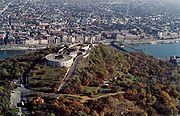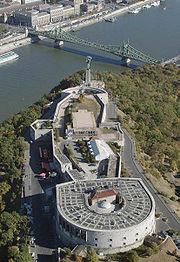
Citadella
Encyclopedia


Hungarian language
Hungarian is a Uralic language, part of the Ugric group. With some 14 million speakers, it is one of the most widely spoken non-Indo-European languages in Europe....
word for Citadel
Citadel
A citadel is a fortress for protecting a town, sometimes incorporating a castle. The term derives from the same Latin root as the word "city", civis, meaning citizen....
, a kind of fortress
Fortification
Fortifications are military constructions and buildings designed for defence in warfare and military bases. Humans have constructed defensive works for many thousands of years, in a variety of increasingly complex designs...
. The word Citadella is exclusively used by other languages to address the Citadel located upon the top of the strategic
Military strategy
Military strategy is a set of ideas implemented by military organizations to pursue desired strategic goals. Derived from the Greek strategos, strategy when it appeared in use during the 18th century, was seen in its narrow sense as the "art of the general", 'the art of arrangement' of troops...
Gellért Hill
Gellért Hill
Gellért Hill is a high hill overlooking the Danube in Budapest, Hungary. It is part of the 1st and 11th Districts. Gellért Hill was named after Saint Gerard who was thrown to death from the hill. The famous Hotel Gellért and the Gellért Baths can be found in Gellért Square at the foot of the...
in Budapest
Budapest
Budapest is the capital of Hungary. As the largest city of Hungary, it is the country's principal political, cultural, commercial, industrial, and transportation centre. In 2011, Budapest had 1,733,685 inhabitants, down from its 1989 peak of 2,113,645 due to suburbanization. The Budapest Commuter...
, Hungary
Hungary
Hungary , officially the Republic of Hungary , is a landlocked country in Central Europe. It is situated in the Carpathian Basin and is bordered by Slovakia to the north, Ukraine and Romania to the east, Serbia and Croatia to the south, Slovenia to the southwest and Austria to the west. The...
.
History
The fortress was built in 1851 by Julius Jacob von HaynauJulius Jacob von Haynau
Julius Jacob von Haynau was an Austrian general.The illegitimate son of the landgrave of Hesse-Kassel, William I and Rebecca Richter, a Jewish woman, he entered the Austrian army as an infantry officer in 1801 and saw much service in the Napoleonic wars...
, a commander of the Habsburg Monarchy
Habsburg Monarchy
The Habsburg Monarchy covered the territories ruled by the junior Austrian branch of the House of Habsburg , and then by the successor House of Habsburg-Lorraine , between 1526 and 1867/1918. The Imperial capital was Vienna, except from 1583 to 1611, when it was moved to Prague...
, and designed by Emánuel Zita and Ferenc Kasselik, after the Hungarian Revolution of 1848
Hungarian Revolution of 1848
The Hungarian Revolution of 1848 was one of many of the European Revolutions of 1848 and closely linked to other revolutions of 1848 in the Habsburg areas...
. It occupies almost the entire 235 metres high plateau. The fortress is a U-shaped structure built about a central courtyard, being 220 metres long, 60 metres wide, and 4 metres tall. It had a complement of sixty cannons.
Actually built by Hungarian forced labourers, it was finished in 1854. In June 1854 Austrian troops settled in the citadel. After the Austro-Hungarian Compromise of 1867 and the establishment of Austria–Hungary, the Hungarians demanded the destruction of the Citadel, but the garrison troops left only in 1897, when the main gate was symbolically damaged. It was not until late 1899 when the city took possession of the Citadel. A few months later, in 1900, the walls were demolished.
In the Hungarian Revolution of 1956, Soviet troops occupied the Citadella. Tanks fired down into the city during the assault that overthrew the Nagy
Imre Nagy
Imre Nagy was a Hungarian communist politician who was appointed Chairman of the Council of Ministers of the People's Republic of Hungary on two occasions...
-led Hungarian government.
Environs
From the top of the Citadel, there is a panoramic view over the city, the DanubeDanube
The Danube is a river in the Central Europe and the Europe's second longest river after the Volga. It is classified as an international waterway....
and its eight bridges.
On the plateau and nearby are other points of interest like the Liberty Statue
Liberty Statue (Budapest)
The Szabadság Szobor or Liberty Statue in Budapest, Hungary, was first erected in 1947 in remembrance of the Soviet liberation of Hungary from Nazi forces during World War II. Its location upon Gellért Hill makes it a prominent feature of Budapest's cityscape.The 14 metre tall bronze statue...
, Hotel Gellért
Hotel Gellért
Hotel Gellért is a famous, first class four star hotel in Budapest, Hungary. The hotel was erected on the right bank of the river Danube between 1916 and 1918 in the Art Nouveau style with some biomorphic elements, at the foot of Gellért Hill, next to Szabadság Bridge.The four star Danubius Hotel...
, the Gellért Baths
Gellért Baths
Gellért Thermal Baths and Swimming Pool, also called Gellért fürdő or Gellért Baths, are a bath complex in Budapest, Hungary, built between 1912 and 1918 in the Art Nouveau style. They were damaged during World War II, but then rebuilt. References to healing waters in this location are found from...
and the Gellért Hill Cave
Gellért Hill Cave
The Gellért Hill Cave is part of a network of caves within Gellért Hill in Budapest, Hungary. The cave is also referred to as "Saint Ivan's Cave" , regarding a hermit who lived there and is believed to have used the natural thermal water of a muddy lake next to the cave to heal the sick...
.

